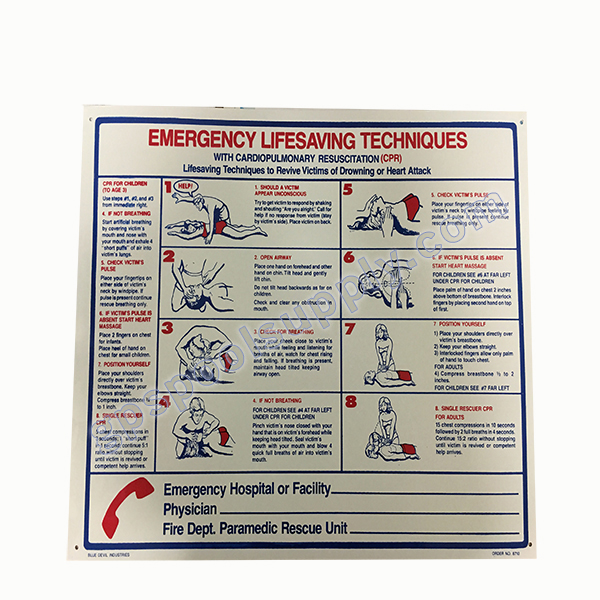Cardiopulmonary Resuscitation (CPR) is a life-saving technique that involves chest compressions and rescue breaths to restore blood circulation and breathing in cases of cardiac arrest. CPR doubles or triples the chances of survival during cardiac arrest episodes.
By performing CPR, you provide oxygen to the brain, keeping the person alive until professional medical help arrives. It can be crucial in saving lives, especially when immediate medical attention is not readily available. Understanding CPR and knowing how to administer it properly can make a significant difference in emergencies where every second counts.
We will explore the basics of CPR, its importance, and the correct steps to perform CPR effectively.
The Importance Of Cpr
CPR is crucial for saving lives during cardiac emergencies by maintaining blood flow and oxygen circulation. Immediate action can make a significant difference in increasing the chances of survival until professional help arrives. Learning CPR skills can empower individuals to respond effectively in critical situations and be a valuable asset to their community.
CPR is a vital life-saving technique that can make a significant difference in emergencies. Quick application of CPR can double or triple survival rates for individuals experiencing cardiac arrest.
History Of Cpr
CPR has evolved over centuries, from ancient times to the modern technique of chest compressions and rescue breaths. The method as we know it today was developed in the 1960s.
Statistics On Cpr Success Rates
– CPR increases the chances of survival – Success rates vary but early initiation is crucial – Immediate CPR can boost survival rates significantly.
Understanding Cardiac Arrest
Cardiac arrest is a sudden stop in heart function, leading to interrupted blood flow. CPR can help by providing chest compressions and rescue breaths, maximizing the chances of survival. Learning CPR can equip you with the skills needed to save a life during a sudden cardiac emergency.
Cardiac arrest is a life-threatening condition that occurs suddenly and without warning. It happens when the heart suddenly stops beating or beats irregularly, preventing it from effectively pumping blood to the rest of the body. This lack of circulation deprives vital organs, including the brain, of oxygen and nutrients, leading to potential brain damage or death. Understanding the causes of cardiac arrest and differentiating it from a heart attack is crucial in recognizing the signs and taking immediate action to save someone’s life.
Causes Of Cardiac Arrest
There are various causes that can trigger a sudden cardiac arrest. Some common factors include:
- Coronary artery disease
- Heart rhythm abnormalities
- Heart muscle abnormalities
- Drug overdose
- Electrocution
- Severe bleeding
It’s important to note that cardiac arrest can also occur in individuals who are seemingly healthy and have no previous heart problems. This is known as sudden cardiac arrest (SCA) and can often be related to an underlying genetic or structural abnormality within the heart.
Difference Between Heart Attack And Cardiac Arrest
While the terms “heart attack” and “cardiac arrest” are often used interchangeably, they are two distinct conditions with different causes and symptoms. Understanding the difference is crucial in providing the appropriate treatment and response. A heart attack occurs when there is a blockage in one or more of the coronary arteries, which are responsible for supplying the heart muscles with oxygen-rich blood. This blockage is usually caused by a blood clot forming on a plaque within the artery. The symptoms of a heart attack include:
- Chest pain or discomfort
- Shortness of breath
- Nausea or vomiting
- Pain radiating to the arms, back, neck, jaw, or stomach
- Light-headedness or fainting
On the other hand, cardiac arrest occurs when the heart’s electrical system malfunctions, leading to an irregular heartbeat or complete cessation of heart function. The symptoms of cardiac arrest are sudden and usually include:
- Sudden loss of consciousness
- No pulse or breathing
- Unresponsiveness
It’s important to remember that while a heart attack can potentially lead to cardiac arrest, not all heart attacks result in cardiac arrest. Prompt recognition, early CPR, and the use of an automated external defibrillator (AED) are vital in improving the chances of survival for someone experiencing cardiac arrest. Remember, awareness and understanding of cardiac arrest are essential for responding quickly and effectively when it occurs. By identifying the causes and distinguishing it from a heart attack, you’ll be better equipped to help save lives in critical situations.
Signs Of Cardiac Arrest
Cardiopulmonary Resuscitation (CPR) is a crucial life-saving technique that can significantly improve the chances of survival during cardiac arrest. Recognizing the signs of cardiac arrest is essential as it enables individuals to promptly initiate CPR, which can make a critical difference in the outcome. Understanding the signs of cardiac arrest empowers you to take immediate action and potentially save a life.
Identifying Cardiac Arrest
Cardiac arrest is a sudden loss of heart function, typically caused by an electrical disturbance in the heart that disrupts its pumping action. It can occur suddenly and without warning, leading to an immediate loss of consciousness and cessation of normal breathing.
Symptoms Of Cardiac Arrest
The signs and symptoms of cardiac arrest include sudden collapse, loss of responsiveness, and absence of normal breathing. Individuals in cardiac arrest may also exhibit gasping, agonal respirations, which appear as irregular, labored breathing. It’s crucial to recognize these symptoms and act swiftly to initiate CPR and seek immediate medical assistance.
Basic Life Support (bls) Procedures
Learn the essential Basic Life Support (BLS) procedures for Cardiopulmonary Resuscitation (CPR). Gain the knowledge and skills needed to provide potentially life-saving assistance in emergency situations.
Basic Life Support (BLS) procedures are crucial for providing immediate care in life-threatening situations such as cardiac arrest. BLS involves a set of actions aimed at sustaining life and aiding the circulation of oxygenated blood to the body’s vital organs. One of the essential components of BLS is Cardiopulmonary Resuscitation (CPR), which involves chest compressions and rescue breaths. Familiarizing oneself with the steps of BLS and understanding the proper technique for performing chest compressions is critical for executing effective CPR.
Steps Of Bls
Performing basic life support comprises several key actions, including checking the scene for safety, assessing the victim’s responsiveness, activating emergency medical services, performing chest compressions, and delivering rescue breaths. These fundamental steps form the foundation of BLS and are essential for effectively responding to cardiac arrest situations.
Performing Chest Compressions
When performing chest compressions, it is imperative to place the heel of one hand on the center of the victim’s chest and interlock the fingers of the other hand. Apply pressure to the chest to a depth of at least 2 inches and at a rate of 100 to 120 compressions per minute. Allow for full chest recoil after each compression to enable the heart to refill with blood. By mastering the basics of BLS procedures, individuals can contribute to potential life-saving efforts in emergency situations. Understanding the correct steps of BLS and the proper technique for performing chest compressions is valuable knowledge that empowers individuals to make a difference in sudden cardiac arrest scenarios.
The Abcs Of Cpr
CPR is a crucial life-saving skill that everyone should be familiar with. When it comes to CPR, understanding the ABCs (Airway, Breathing, and Circulation) is essential. Knowing the correct techniques for airway management and breathing can make a significant difference in emergency situations.
Airway Management
Airway management is the first step in CPR and involves ensuring that the person’s airway is clear and unobstructed, allowing for effective breathing. When positioning the person for CPR, remember to tilt their head back to open the airway and remove any visible obstructions such as food or foreign objects. The goal is to establish clear airflow for effective resuscitation.
Breathing Techniques
In CPR, breathing techniques play a critical role in delivering oxygen to the person in need. After ensuring the airway is clear, it’s important to focus on providing rescue breaths. Place your mouth over the person’s mouth and nose, and deliver two slow breaths, ensuring that the chest rises with each breath. This helps to supply oxygen to the person’s lungs and vital organs.

Credit: www.uscpronline.com
Advanced Life Support (als) Techniques
One of the crucial aspects of CPR is the application of Advanced Life Support (ALS) techniques.
Use Of Aeds
Automated External Defibrillators (AEDs) deliver electric shocks to restore heart rhythm during cardiac arrest.
Administering Medications
Medications like epinephrine and anti-arrhythmic drugs are given to stabilize the patient’s condition.
Special Considerations In Cpr
Cardiopulmonary Resuscitation (CPR) is a crucial life-saving technique used in emergency situations to restore the circulation and breathing of a person who has experienced cardiac arrest or has stopped breathing. While the basic principles of CPR remain the same across different age groups and conditions, there are some special considerations to keep in mind when performing CPR on children or pregnant women.
Cpr In Children
CPR in children follows the same general steps as in adults, but there are a few important differences to be aware of:
- Airway clearance: When performing CPR on a child, it’s crucial to ensure the airway is clear of any obstructions, as children may be more prone to choking on small objects or their own tongue during cardiac arrest. Be cautious to remove any potential barriers before initiating rescue breaths.
- Compression depth: The depth of chest compressions in children should be shallower compared to that in adults. It is generally recommended to depress the chest by about one-third of its depth, aiming for a depth of approximately 2 inches (5 centimeters).
- Compression-to-ventilation ratio: Unlike adult CPR, which follows a ratio of 30 compressions to 2 rescue breaths, CPR in children involves 15 compressions followed by 2 breaths. This modified ratio allows for adequate oxygenation while maintaining effective circulation.
- Assessment of pulse: Checking for a pulse in a child may be more challenging than in adults due to their smaller size and weaker pulses. In cases where it is difficult to detect a pulse within 10 seconds, it is recommended to initiate CPR immediately.
Cpr For Pregnant Women
CPR for pregnant women requires some additional considerations due to the presence of the unborn baby:
- Placement of hands: When positioning your hands for chest compressions, it is important to place them slightly higher than usual. By locating your hands on the sternum, just below the breasts, you can ensure effective compression of the heart while minimizing the risk of injury to the fetus.
- Modification of airway management: Take special care to position the pregnant woman’s head slightly tilted back to maintain an open airway. Be cautious not to overextend the neck, as it may inhibit blood flow to the growing fetus.
- Compression force: Adjust the force applied during chest compressions to account for the changes in body structure brought about by pregnancy. Take care not to apply excessive pressure that could harm the unborn baby.
- Reassessing the woman’s condition: Continuously reassess the pregnant woman’s condition throughout CPR to monitor any changes in responsiveness, breathing, or circulation. Prioritize getting immediate medical assistance for both the mother and unborn child.
Training And Certification
Cardiopulmonary Resuscitation (CPR) is a life-saving technique that can make a significant difference in emergency situations. Performing CPR correctly requires proper training and certification to ensure that individuals have the skills and knowledge needed to provide effective assistance during a cardiac or respiratory arrest. CPR training courses and certification renewal are essential steps towards becoming a prepared and capable individual ready to handle emergency situations. Let’s explore the importance of CPR training courses and the process for renewing CPR certification.
Cpr Training Courses
CPR training courses are designed to equip individuals with the knowledge and skills necessary to perform CPR correctly. These courses are typically facilitated by certified instructors who guide participants through the techniques, steps, and procedures of CPR. Attending a CPR training course provides hands-on practice and practical scenarios to enhance understanding and build confidence in performing CPR.
During the training, participants will learn about the importance of early recognition of cardiac arrest, the steps of the CPR process, proper positioning and hand placement for compressions, and the use of an Automated External Defibrillator (AED) if available. CPR training courses also cover important topics such as the assessment of responsiveness, checking for breathing and circulation, and the proper administration of rescue breaths. Participants will gain valuable knowledge on how to provide competent, immediate care, potentially saving a life.
In addition to the practical skills, CPR training courses educate participants on the legal aspects and ethical considerations of performing CPR. These courses also emphasize the importance of maintaining personal safety and the well-being of the victim while providing assistance. Participants will become familiar with the Chain of Survival and the roles of emergency medical services (EMS) and healthcare professionals in the overall process of resuscitation.
Renewing Cpr Certification
CPR certification is not a lifetime achievement; it requires regular renewal to ensure that individuals stay up-to-date with the latest techniques and guidelines. The American Heart Association (AHA) and other recognized organizations typically require certification renewal every two years.
Renewing CPR certification involves completing a refresher course, which allows individuals to review and reinforce their knowledge and skills. These courses are designed to provide updates on new guidelines, modifications in techniques, and any changes to the CPR algorithm. Attending a CPR certification renewal course ensures that individuals remain competent and confident in their ability to provide effective CPR when the need arises.
It is important to note that some organizations have specific requirements for CPR recertification, such as completing additional training in specialized areas like pediatric CPR or first aid. Therefore, individuals should check with their certifying organization to ensure they meet all the necessary criteria for renewal.
In conclusion, CPR training courses are essential for individuals who want to be prepared to respond effectively in emergency situations. These courses equip individuals with the knowledge and skills needed to perform CPR correctly. CPR certification renewal ensures that individuals stay current with guidelines and continue to be competent in providing life-saving assistance. By receiving training and maintaining certification, individuals can make a significant impact in emergency situations, potentially saving lives.
Legal Implications Of Cpr
CPR carries legal implications that individuals should understand, especially concerning Good Samaritan Laws and liability in various CPR situations.
Good Samaritan Laws
Good Samaritan Laws offer legal protection to individuals who provide reasonable assistance during emergencies, including CPR, shielding them from liability.
Liability In Cpr Situations
In CPR situations, liability may arise if an individual provides care negligently or fails to obtain consent (if applicable), potentially leading to legal repercussions.

Credit: bestpoolshop.com

Credit: www.gpspoolsupply.com
Frequently Asked Questions For Cardiopulmonary Resuscitation (cpr)
What Are The Steps Of Performing Cpr?
Performing CPR involves the following steps: checking for responsiveness, calling for help, performing chest compressions, and giving rescue breaths if trained.
When Should Cpr Be Performed?
CPR should be performed when a person is unresponsive, not breathing, or without a pulse. It is crucial to start CPR immediately in these situations.
Is Cpr Different For Adults And Children?
Yes, CPR techniques for adults and children differ. The rate and depth of chest compressions, as well as the method of providing rescue breaths, are adjusted based on the age of the patient.
How Does Cpr Help In Saving Lives?
CPR helps in saving lives by maintaining the blood flow to vital organs, such as the brain and heart, until further medical help arrives. It can increase the chances of survival after cardiac arrest.
Conclusion
Understanding the importance of cardiopulmonary resuscitation (CPR) is crucial for saving lives. By learning how to perform CPR, individuals can effectively respond to emergencies and provide immediate aid until professional help arrives. Remember, CPR can make a significant difference in increasing survival rates and minimizing the effects of cardiac arrest.
Stay prepared and confident in your ability to intervene during critical situations. Stay proactive in acquiring CPR training and become a valuable asset in your community. Together, we can ensure the well-being of those in need.




